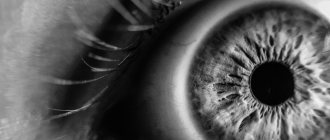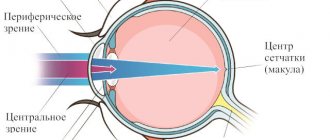Many have experienced an unpleasant flicker in their eyes. This phenomenon can occur only once, but in some cases it becomes regular, periodically reminding itself. The causes of flicker in the eyes often lie in the development of serious diseases that everyone should know about. Knowledge of how certain diseases associated with flicker manifest themselves will help determine what exactly could cause such a symptom.
Flickering in the eyes, reasons:
An alarming sign is bright flashes that repeat constantly. If they are accompanied by severe migraine, tinnitus and dizziness, visit the clinic immediately for consultation with a doctor. Since these symptoms signal the beginning of destructive processes in the body.
There are many reasons why “bunnies” appear before your eyes. Almost all of them are associated with a malfunction of the central nervous system. The pathology is accompanied by poor circulation, which leads to increased blood pressure and causes problems in the functioning of internal organs.
Most often, glare is caused by a disruption in blood circulation and an increase in intracranial pressure. In this case, the patient observes black and white dots in front of his eyes. Also, “bunnies” can be caused by overflow of the blood vessels of the visual apparatus.
In addition, the manifestation of unpleasant symptoms is caused by:
- Lack of vitamins, anorexia, exhausting diets;
- Hypertension or hypotension. In this case, in addition to glare, a person observes floating dots and darkening;
- Consumption of large quantities of alcoholic beverages and tobacco products;
- Problems with the spine. The appearance of “flies” signals pinching of nerve endings and blood vessels, and a disruption in blood flow occurs. As a result, not only the eyes, but also the spinal cord are affected;
- Anemia. Flickering is observed regularly;
- Damage to the organ of vision;
- Emotional overload, stress;
- Intoxication;
- Hemarthrosis in the brain. In this case, a person observes “fly spots” flashing before his eyes, which portends a loss of consciousness;
- Increased blood sugar levels. Severe diabetes affects the vascular system;
- Trauma of the skull;
- Internal bleeding.
| Glare in the eyes can be observed in pregnant women. This is a very dangerous symptom that can harm the health of the expectant mother and baby, so immediately consult a doctor for a comprehensive examination. |
“Bunnies” may appear after prolonged exposure to the sun. They are the first sign of sunstroke.
What happens as you age?
Somewhere after 30 years, new “midges” often begin to appear, and after 40 years, hyaluronic acid is gradually lost, the transparency of the vitreous body decreases, and visualization of fibers appears.
Even later, the vitreous body dries out altogether and begins to peel off from the retina (it simply comes off in places where there is no attachment).
Vitreous detachment is a normal sign of aging.
it is caused by liquefaction of the vitreous body, leading to tension in the retina in places of strong attachment, which can lead to retinal rupture. Acute vitreous detachment leads to retinal tears in 15% of cases.
Figuratively speaking, a kind of “snot” of gel (this is a very imprecise description of this type of tissue, but gives a very good understanding) hangs out inside the eye. Then this “clump of gel” comes off the optic nerve. As a rule, the separation zone looks like a ring (Weiss ring), that is, when projected onto the retina, the result is what patients call a “spider”, “big midge”, “figure eight”, “dark spot”, “analemma”, “circle” " and so on. The kaleidoscope can change: every day a new form. If the fastening ring does not come off, but simply stretches out, to hell with the kaleidoscope, you can live. But if it pulled the retina and tore off a piece, then there are retinal tears, detachments, and in general a lot of troubles.
This is how the ophthalmologist sees the Weiss ring:
Treatment of tears before retinal detachment occurs is laser photocoagulation of the tear zones in several rows along the edge, so that the formed fusion sites hold the retina in place.
All this is treated with a good prognosis if you contact an ophthalmologist within the first days, with an average prognosis if you contact an ophthalmologist within a month. If the detachment has begun and the fluid that has entered through the gap continues to flow under the retina, peeling it off, the problems begin to become irreversible, and the question is about preserving vision as such, at least with some optical quality.
Therefore, if you suddenly see a lot of new “midges”, or they behave somehow strangely, or something else incomprehensible is happening in the eye, you should urgently go to an ophthalmologist.
What diseases have this symptom?
Lightning and patterns before the eyes signal the development of a number of pathologies:
- High blood pressure. In this case, a spasm of the vascular system located in the retina of the organ of vision is observed. Hemarthrosis occurs, which disrupts eye function;
- Low pressure. Not enough oxygen enters the vascular system, which causes glare;
- Cervical osteochondrosis. Displacement of the vertebrae leads to pinched nerve endings, they do not receive enough blood;
- Reduced hemoglobin level. Anemia causes dizziness, constant flickering and vision problems;
- Increased sugar content in the circulatory system. As a result, the retina of the eye is affected and glare appears;
- Ophthalmological pathologies. The cause of “bunnies” can be cataracts or glaucoma;
- Migraine. Bright flashes are heralds of a severe headache;
- Eclampsia. The disease is diagnosed in pregnant women in late stages. If the first symptoms of pathology occur, immediately contact the clinic. The disease poses a threat to the health of the expectant mother and her baby;
- Lack of vitamins. To eliminate unpleasant symptoms, balance your diet and take a vitamin course;
- Poisoning of the body. In this case, damage occurs to the nerves located in the visual apparatus.
Only a doctor can identify the disease that caused the glare after carrying out a series of diagnostic measures.
What ophthalmic diseases cause flicker?
These pathologies include:
- Myopia;
- Swelling of the cornea. As a result, the nerve endings of the organ of vision are compressed and small vessels are damaged;
- Mechanical eye injury;
- Inflammation of the uveal tract;
- Deviations in the retina, causing its detachment;
- Destruction of the vitreous body. The moisture contained inside the eye changes its consistency and becomes more liquid. The eye tissue also thickens and shrinks;
- Cataracts or glaucoma can cause the anomaly.
| An ophthalmologist will be able to diagnose a disease that causes the regular appearance of glare after an examination. |
Other diseases
Lightning, bright flashes, and “bunnies” are often not associated with the development of eye pathologies. For example, oscillopsia causes unpleasant symptoms. In this case, glare appears if you turn your head sharply or change your body position.
Problems with the spine can also provoke the appearance of flickering. Visual acuity and the functioning of the vestibular apparatus are directly related to the functioning of the vertebral arteries. Their pinching is accompanied by the following signs:
- Side glare that slowly spreads across the entire visual field;
- The appearance of white dots, temporary blindness;
- Increased flicker;
- Increased blood pressure.
| The doctor will be able to determine the cause of the bright flashes after a visual examination and collection of the necessary tests. |
Diagnostics
If flickering has become regular or is accompanied by serious symptoms, then you cannot do without visiting a doctor. First you need to visit an ophthalmologist. After an examination and a short conversation, the doctor will determine whether there is a need to consult with other specialists, and will also prescribe several important examinations.
You will need:
- Blood and urine tests;
- Ophthalmoscopy;
- Ultrasound;
- CT.
You need to undergo examinations as soon as possible, because... Some diseases require the fastest possible therapeutic intervention. If you delay, there is a risk of encountering complications that will be very difficult to treat.
Flickering and headache
There are several factors that cause this symptomatology:
- Ophthalmological pathologies;
- Osteochondrosis;
- Problems with the heart and blood vessels;
- Psycho-emotional stress;
- Migraine.
If the visual apparatus malfunctions, the headache becomes stronger if you turn around sharply. Also, unpleasant sensations are intensified by loud sounds and bright lights. Additionally, signs such as increased lacrimation, pain in the temples and back of the head, dizziness, weakness and drowsiness are observed. Taking painkillers will help you feel better.
Development factors
The fact that a headache and flickering in the eyes may occur is influenced by the following factors:
- Change in atmospheric pressure. The blood vessels of the brain react to changes, causing headaches, flickering in the eyes, and ripples appearing.
- Decreased blood oxygen levels. This happens when working for a long time inside an unventilated room.
- Compressing the vessels of the neck is an uncomfortable position with a tilted, thrown back head, which leads to a decrease in nutrition of the brain, and the head may also hurt.
- Exhaustion of the body.
- Exposure to toxic substances (nicotine, alcohol, food with chemical additives).
- Chronic stress.
Twinkle in the eyes from the side
A similar anomaly is often observed in women after forty years, it is during this period that menopause most often occurs. Also, girls expecting a child may notice side flickering. The reason lies in the adjustment of hormonal levels. During this period, all internal organs and systems undergo changes.
Detachment of the posterior limiting membrane or its destructive pathologies can cause “bunnies”.
If you are concerned about side flicker, measure your blood pressure. In some cases, similar symptoms are observed if the eyes are closed. The cause of the development of the anomaly is hypertension, as a result of which blood circulation in the vascular system of the organ of vision is disrupted.
Features of treatment
The doctor should select therapy after carrying out all diagnostic measures. The main purpose of treatment is to eliminate the cause that caused the appearance of “bunnies” before the eyes. If the “root of evil” lies in a malfunction of the internal organs, medications are selected to combat the disease. If the cause is hidden in ophthalmic ailments, you will need to undergo a course of therapy, including:
- For three months, use a 1% solution of Emoxipin three times a day. It strengthens the blood vessels of the eye, normalizes the circulation of intraocular fluid, and provides the retina with protection from harmful ultraviolet radiation;
- For two weeks, take Wobenzym three times a day. It blocks inflammation, provides tissues with necessary substances, eliminates pain;
- Take a course of vitamins containing lutein;
- Homeopathic substances are useful: ustigalo, crocus, etc.
As an addition to therapy, the doctor can select a special diet, which is based on the exclusion of harmful foods from the diet.
Where to sign up for testing
The easiest way to choose a diagnostic center in St. Petersburg is through our service. There is comprehensive information about addresses, telephone numbers, and opening hours of clinics. You can find out what protocols are used for the examination. Clarify the qualifications of doctors and equipment models. Using the website, it is easy to find out which medical centers are ready to accept patients with limited mobility, and where parking is provided on the territory of the institution. It is convenient to reserve a coupon and receive up to 1000 rubles discount on diagnostics by phone. Our specialists will answer all questions daily from 8:00 to 24:00. The service is free.
Preventive measures to improve vision
There are several simple recommendations that will prevent the appearance of “bunnies” before your eyes:
- Create a balanced diet. The body must receive the required amount of proteins, fats and carbohydrates every day. Include fresh herbs, nuts, fruits and vegetables in your menu. If possible, consult a nutritionist, he will help you choose the optimal diet;
- Give your eyes rest and avoid overstrain. This is especially true for those who spend a lot of time at the computer. Take a break every hour, and during moments of rest, do simple gymnastics;
- Gather your willpower and give up bad habits. They negatively affect the health of not only the eyes, but also the entire body;
- Take medications after consulting a doctor;
- Play sports and walk more in the fresh air;
- On a sunny day, do not go outside without protective equipment;
- Sleep at least eight hours a day and avoid stress.
| Flickering in the eyes is an unpleasant symptom, but if you follow simple preventive measures, you can avoid its manifestation and minimize the risk of developing various pathologies. |
Traditional methods
You can get rid of flicker at home. Folk remedies that have worked well in the past will help you cope with the problem. The wide variety of methods can be confusing and the effectiveness of such treatment will suffer. Therefore, it is recommended to give preference to the following methods:
- Honey with aloe juice. Mix them in equal quantities to achieve a homogeneous consistency. Place 2 drops into eyes morning, afternoon and evening. The course of treatment is 2 weeks.
- Cucumber juice. Grate the cucumber and squeeze out all its juice through cheesecloth. Mix with water in equal quantities, blot a cloth in the mixture and place on your eyes.
- Chamomile decoction. Pour 250 ml of boiling water over 3 tablespoons of flowers, leave covered until completely cool, strain. Rinse your eyes with the mixture once daily.
After using such products, flickering spots in front of the eyes should stop forming. However, you should consult your doctor in advance, because... in some cases, traditional methods may be contraindicated.










